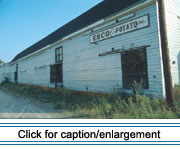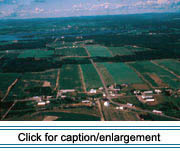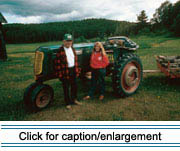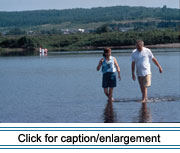|
 Acadian Culture in Maine documents much of cultural importance.
It is the first step in providing an adequate information base about Acadian
culture in Maine. But this report must not be regarded as a sufficient
base for future programming and conservation efforts. Much has yet to
be discovered and understood about Acadians in Maine. For instance, the
report does not present sufficient detail regarding the diversity of experience
of Maine Acadians. Cultural institutions and what they mean to contemporary
Maine Acadians have not yet been systematically studied or analyzed. Historical
context has been given for certain physical manifestations of material
culture, but there is limited data about what changes occurred, the mechanisms
for change, and how the change has been incorporated into the worldview
of the people. The geographic scope of the study was limited to a few
communities in the Upper St. John Valley; a broader scope is needed in
the Valley, northern Aroostook County, and other areas of Maine. Due to
time limitations, folklife fieldworkers were unable to document the full
seasonal round of activities.
Acadian Culture in Maine documents much of cultural importance.
It is the first step in providing an adequate information base about Acadian
culture in Maine. But this report must not be regarded as a sufficient
base for future programming and conservation efforts. Much has yet to
be discovered and understood about Acadians in Maine. For instance, the
report does not present sufficient detail regarding the diversity of experience
of Maine Acadians. Cultural institutions and what they mean to contemporary
Maine Acadians have not yet been systematically studied or analyzed. Historical
context has been given for certain physical manifestations of material
culture, but there is limited data about what changes occurred, the mechanisms
for change, and how the change has been incorporated into the worldview
of the people. The geographic scope of the study was limited to a few
communities in the Upper St. John Valley; a broader scope is needed in
the Valley, northern Aroostook County, and other areas of Maine. Due to
time limitations, folklife fieldworkers were unable to document the full
seasonal round of activities.
It is tempting, with programming in mind, to mount research keyed to
specific arts or other forms of cultural expression. However, a systematic,
extended, in-depth documentary study of the culture would be more productive
in the long run. It should include contributions from qualified scholars
with expertise in regional history and culture. Research should include
members of the Maine Acadian community as research associates and others
from the community as reviewers, providing feedback on the end products.
The following are some specific areas which warrant serious research.
Archeology
Archeological resources are an integral part of the investigation into
Maine Acadian culture. A reconnaissance "walk-over" survey is needed to
identify and describe sites, and assess their potential to provide data
on the material culture and cultural adaptations of the early French-speaking
settlers in the study area. The overview should be coordinated with a
Valley-wide survey of cultural resources and followed by specific site
investigations and documentation, as called for. The survey should be
conducted in conjunction with the state historic preservation officer.
|
 |
 |
Architecture
 Architectural resources warrant a reconnaissance "windshield" survey of
properties over 50 years in age. Such a survey should be coordinated with
a Valley-wide survey of cultural resources. Preliminary work should be
followed by intensive surveys as called for. The survey should be conducted
in conjunction with the state historic preservation officer and could
enlist the skills and resources of the Historic American Buildings Survey/Historic
American Engineering Record of the National Park Service. Consideration
should also be given to the potential importance of properties of cultural
significance that are less than 50 years old.
Architectural resources warrant a reconnaissance "windshield" survey of
properties over 50 years in age. Such a survey should be coordinated with
a Valley-wide survey of cultural resources. Preliminary work should be
followed by intensive surveys as called for. The survey should be conducted
in conjunction with the state historic preservation officer and could
enlist the skills and resources of the Historic American Buildings Survey/Historic
American Engineering Record of the National Park Service. Consideration
should also be given to the potential importance of properties of cultural
significance that are less than 50 years old.
Some of the most important properties fall within the following categories:
(a) dwellings--log farmhouses and village houses from the early to late
19th century; early- to mid-20th-century farmhouses; seasonal lake camps;
(b) farm buildings--pignon simple (simple-gable) barns; twin barns;
comble cassé (gambrel-roof) barns; large, early-20th-century, simple-gable
grain and hay barns; potato houses; tool and equipment sheds; (c) religious
properties and sites-- all churches; presbyteries; convents; roadside
and memorial crosses and shrines; cemeteries; sacred places; (d) school
buildings-- Catholic Church schools; wood-frame public schoolhouses; early-
to mid-20th-century brick buildings; (e) mills and historical mill sites--
buckwheat, carding, lumber, and others; (f) sites associated with the
railroad--starch factories; railroad potato warehouses; train depots and
stations.
Cultural Land Use Survey
 All lands in the Upper St. John Valley have been utilized and/or modified
by Euro-Americans to some degree, even portions that appear to be pristine.
A comprehensive knowledge of the geological, ecological, and cultural
history of the area is a prerequisite to understanding Acadian culture
in Maine. A cultural land use study from the cultural/historical geography
approach--utilizing geography's emphasis on discovering patterns--will
best lay the foundation for understanding some of the present land formations,
land boundaries, exploited/exploitable natural resources, extant cultural
resources, and potential archeological resources. Defining patterns, developing
a context for the patterns, and assessing the resources within that context
will provide the necessary background for understanding the features of
the Upper St. John Valley landscape. The study should be coordinated with
a Valley-wide survey of cultural resources carried out in consultation
with the state historic preservation office.
All lands in the Upper St. John Valley have been utilized and/or modified
by Euro-Americans to some degree, even portions that appear to be pristine.
A comprehensive knowledge of the geological, ecological, and cultural
history of the area is a prerequisite to understanding Acadian culture
in Maine. A cultural land use study from the cultural/historical geography
approach--utilizing geography's emphasis on discovering patterns--will
best lay the foundation for understanding some of the present land formations,
land boundaries, exploited/exploitable natural resources, extant cultural
resources, and potential archeological resources. Defining patterns, developing
a context for the patterns, and assessing the resources within that context
will provide the necessary background for understanding the features of
the Upper St. John Valley landscape. The study should be coordinated with
a Valley-wide survey of cultural resources carried out in consultation
with the state historic preservation office.
Subjects to be addressed by the reconnaissance land use survey include:
(a) land property systems, such as the systems of land allotment utilized
during early settlement, in relation to natural features; (b) land ownership
and land exchanges such as sale, lease, and inheritance systems; (c) extractive
industries, such as logging and mining, with associated land modifications
and infrastructures; (d) agricultural systems, land modifications, and
associated infrastructures; (e) animal husbandry practices and associated
infrastructures; (f) transportation systems and associated infrastructures;
and (g) vernacular place names.
Ethnography
 A systematic, extended, in-depth ethnographic study by a qualified applied
cultural anthropologist is needed. A clearly stated research design is
required, using methods such as participant observation, mini-surveys,
life histories and other oral history, analysis of census data, archival
research, and in-depth interviews. The research team should include members
of the Maine Acadian community as research associates and others from
the community as reviewers, providing feedback on products. Such a study
would focus on qualitative analysis of Acadian cultural identity in the
1990s, as defined through Maine Acadian institutions, context and mechanisms
of cultural change, and family, community, and religion. Looking at social
relationships, ideology, and what local institutions mean to Maine Acadians
will provide cultural and social contexts to data gathered in folklife
and other studies.
A systematic, extended, in-depth ethnographic study by a qualified applied
cultural anthropologist is needed. A clearly stated research design is
required, using methods such as participant observation, mini-surveys,
life histories and other oral history, analysis of census data, archival
research, and in-depth interviews. The research team should include members
of the Maine Acadian community as research associates and others from
the community as reviewers, providing feedback on products. Such a study
would focus on qualitative analysis of Acadian cultural identity in the
1990s, as defined through Maine Acadian institutions, context and mechanisms
of cultural change, and family, community, and religion. Looking at social
relationships, ideology, and what local institutions mean to Maine Acadians
will provide cultural and social contexts to data gathered in folklife
and other studies.
Folklife
Additional documentation of the region's expressive culture is required
for adequate development of programs of many kinds, including performances,
exhibitions, publications, and apprenticeships. Areas of expressive culture
to be documented should include foodways, music, dance, oral traditions,
occupational lore, material culture, religious traditions, and family
and community celebrations.
Historical Documents
 Copies of property records, successions, deeds, vendor/vendee records,
and other documents pertaining to early French-speaking settlers must
be added to those already held in Valley archives and made available to
researchers of Maine Acadian history. Existing documents recorded prior
to United States ownership of a portion of the Upper St. John River Valley
(1785-1842) are presently in Canada (mostly in New Brunswick). Records
pertaining to the early histories of the oldest known Maine Acadian structures
and sites in the Valley are generally not available in Maine.
Copies of property records, successions, deeds, vendor/vendee records,
and other documents pertaining to early French-speaking settlers must
be added to those already held in Valley archives and made available to
researchers of Maine Acadian history. Existing documents recorded prior
to United States ownership of a portion of the Upper St. John River Valley
(1785-1842) are presently in Canada (mostly in New Brunswick). Records
pertaining to the early histories of the oldest known Maine Acadian structures
and sites in the Valley are generally not available in Maine.
Linguistics
The most important study of language in the Valley should be sociolinguistic:
who says what to whom in what context. We must be able to document actual
usage of French and the attitudes of people in the community to the use
of the French language. Investigators trained in the ethnography of communication
must observe the actual language behavior of the people of the Valley:
where and when do they speak French; who are the speakers; why do they
speak French; what kind of French do they speak; what kinds of media use
French as the mode of communication; what are the rules of etiquette for
using French in the community; and what kinds of genres--speeches, songs,
stories, invitations--are typically in French? Only then can we gauge
the strength of the French language and its special place in the Upper
St. John Valley.
Other language research is needed to address questions related the nature
of "Valley French." The insights of lexicologists, dilectologists, phonologists,
and structural grammarians should be sought to better undesrstand and
describe the language in the Valley.
Natural Resources
 The Maine Acadian Culture Preservation Act authorizes the National Park
Service to enter into cooperative agreements with owners of properties
of natural significance associated with the Acadian people of the state
of Maine. Natural resources, the St. John River being chief among them,
have had a profound influence on life in the Valley. A literature review
and basic overview of the area's biotic and abiotic resources will help
define the cultural context of Maine Acadians. The identification of specific
sites of interest should be included in the overview. Given that natural
resources do not respect political boundaries, the effort should be conducted
in cooperation with entities in Canada.
The Maine Acadian Culture Preservation Act authorizes the National Park
Service to enter into cooperative agreements with owners of properties
of natural significance associated with the Acadian people of the state
of Maine. Natural resources, the St. John River being chief among them,
have had a profound influence on life in the Valley. A literature review
and basic overview of the area's biotic and abiotic resources will help
define the cultural context of Maine Acadians. The identification of specific
sites of interest should be included in the overview. Given that natural
resources do not respect political boundaries, the effort should be conducted
in cooperation with entities in Canada.
|
|

